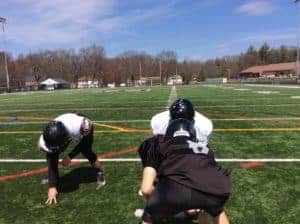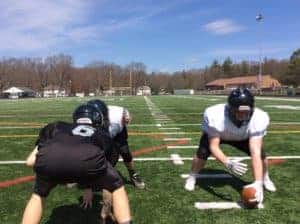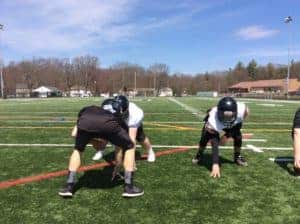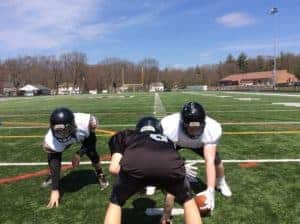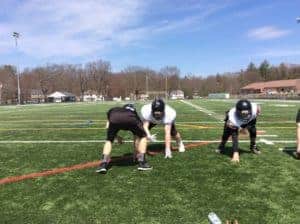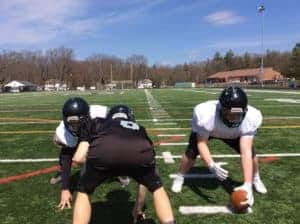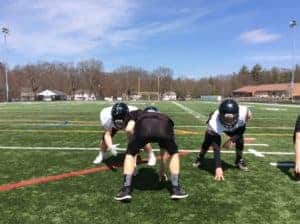The defensive lineman is in charge of controlling the line of scrimmage. Teams who control the line of scrimmage on either side of the ball typically win the game. To control the line of scrimmage, defenses need to defend gaps. What are gaps?
Gaps are the space between the offensive lineman. Between the center and the guard is the A-Gap, between the guard and tackle is the B-Gap, between the tackle and tight end is the C-Gap, and outside out the tight end is the D-gap. Defenses must cover these gaps to stop an effective rushing attack.
In this article, we will show you what gaps are and what techniques defensive linemen line up in to control them. Let’s look at the defensive side of the ball.
Defensive Line Techniques
Defensive line techniques are important in the overall structure and scheme of the defense. The defensive line includes the defensive tackle and defensive end positions.
In order to stop the run, it’s important the defense has gap responsibility or man control.
Two common ways teams control the line of scrimmage:
- Gap Control
- Man control
Gap control is the most common, as players are put into different alignments and must maintain their “Gaps.”
Gap Control
Gaps are the areas between two players that create “holes” for running backs to run through. The bigger the gap, the easier it is for a running back to run full speed through it.
The defense refers to these as gaps; the offense refers to these spaces as “holes.”
The smaller the gap – it forces running backs to slow down or bounce it to the outside. This is what the defense ultimately strives to do – slow the offense and make them work laterally.
Typically, the offense will displace the defensive lineman from their position to try to create these holes. This is more common in power schemes.
In zone schemes, offensive players will try to get the defensive player running and use their speed and leverage to create holes rather than overpower the defender.
This is more common in today’s spread game as teams use the different outside and inside zone schemes to naturally displace defenders.
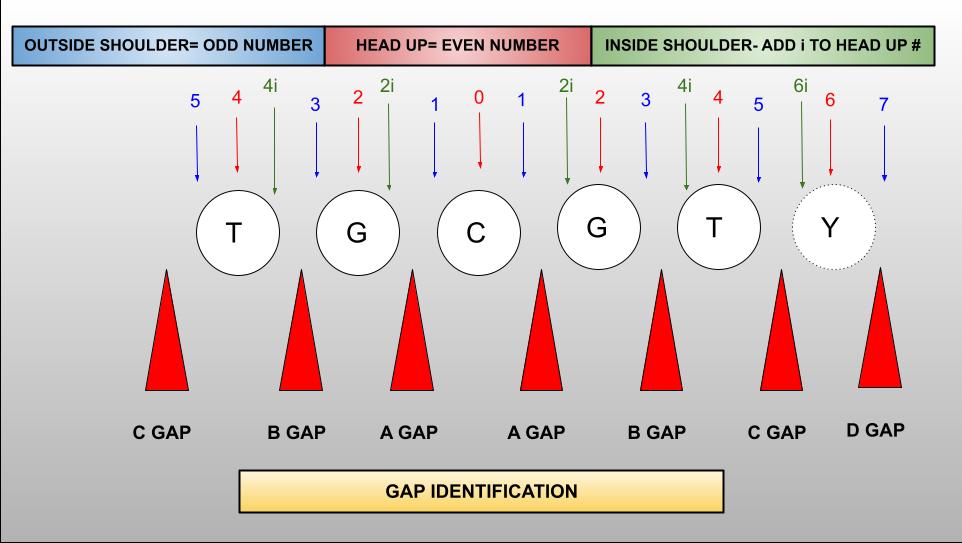
The gaps are broken down into A-Gap, B-Gap, C-Gap, and D-Gap. The gaps are as follows:
- A-Gap – The area between the Center and Guard (on both sides of the line). Protecting the A gaps is most important, as the A gaps are the shortest path to the end zone
- B-Gap – The area between the Guard and Tackle (on both sides of the line).
- C- Gap – The area between the Tackle and Tight End ( on both sides of the line).
- D-Gap – The area outside of the Tight End
Man Control
Now that we know what gaps are let’s look at man control.
Man control is when teams have defensive linemen play through certain linemen to control more than one gap. This is also known as “Two-Gapping.”
Two-gapping requires a defensive lineman to control the opposing offensive lineman, rip off the block and make the tackle. This defensive technique is common in 3-4 Defenses and 4-3 defenses that play an even front.
The defensive techniques & alignments that are often played when playing man control are 0, 2, 4, and 6 techniques.
When the defensive line ( also known as d line), plays two gaps, they are often responsible for stopping the offense’s running game.
Defensive Lineman Alignments
The defensive lineman’s alignment and control of the line of scrimmage is a large part of stopping the run game.
Players are positioned in specific gaps and techniques to ensure they can maintain their gap integrity.
Let’s take another look at the image by Dub Maddox to understand the defensive techniques.
Head-Up Alignments
When a defensive lineman lines up directly in front of the defender, these are identified as even numbers. See the pictures below for a visual reference.
0 Technique: Head-Up The Center
2 Technique: Head-Up The Guard
4 Technique: Head-Up The Tackle
Head-up the Tight End is often referred to as 6!
These are the “man” alignments we mentioned earlier.
Playing a defender head up makes it easier to punch them in both shoulders and play two different gaps.
Outside Alignments
Odd Number techniques identify outside alignments. This is about the defensive lineman lining up on the outside shoulder.
1 Technique: Outside Shoulder Of The Center
3 Technique: Outside Shoulder Of The Guard
5 Technique: Outside Shoulder Of The Tackle
Also known as a 5 tech (five technique), this alignment will often combat offensive tackles and tight ends.
The outside shoulder of the tight end is a 7
Outside alignments help players control guards, tackles, and even the center from the outside.
This helps players get in a better position for the popular “zone” schemes that we often see. It puts players at a disadvantage to play 2 gaps but helps players control 1 gap.
Inside Alignments
Inside alignments are head-up numbers but with an “i” attached. This means they are going to be responsible for the inside alignment.
If the player is in a 2i alignment, they will be responsible for the A gap.
Because we’re working out from the football, there is no “inside” in the center. The inside techniques start with the guard.
2i Technique: The Inside Technique Of The Guard
If the defensive lineman is in a 2i, there’s a good chance they may see a double team from the center and guard.
4i Technique: The Inside Technique Of The Tackle
It’s important to punch the offensive tackle and not let him off the line of scrimmage. Whenever you’re responsible for an inside alignment, stay on the inside shoulder of the tackle and don’t get reached. This means the offensive tackle cuts off your position toward the play. This will result in large gaps in the middle of the defense.
6i Technique: The Inside Technique Of The Tight End
Inside alignments are often seen in 3-man fronts but can also be utilized in 4-man fronts. 4’s and 2’s help defensive tackles and defensive ends punch the guard and tackle and control the inside gap.
Defensive Fronts
Defensive fronts are often identified where the 4 or 3 defensive linemen line up. The most common fronts are identified as follows:
- Over Front
- Under Front
- Bear (Double Eagle) Front
- 4i’s
Over/Under Front
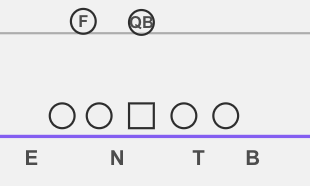
The over and under fronts are similar to each other. They both involve using a 3 technique and a 1 technique. The difference is that the 3 technique in an over front is set TO the strength.
Teams will often dictate strength based on the TE (or in the spread game, they will use opposite/to the running back.
In an under front, the 3 technique is set away from the strength of the running back. This changes the gap responsibilities for the linebackers. There are benefits to each front; it’s all the preference of each coach and how they implement them into their defense.
Bear (Double Eagle) Front
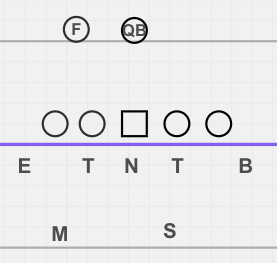
The bear, also known as the double eagle front, utilizes 3 interior linemen. The nose is typically lined up over the center, whether in a 0 or 1 technique.
The other 2 interior linemen are lining up over the guard, either in a 2, 2i, or a 3 technique. This covers the interior lineman and typically allows linebackers to roam free in between the tackles.
4i Front (Tite Front)
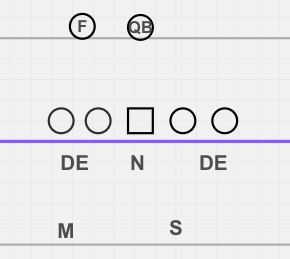
The 4i front is run out of the 3-4. This front gives spread teams trouble as it allows defenses to play aggressively to the run and have an extra defender in the passing game.
Exactly how it sounds, the 4i front uses interior lineman in “4i” techniques, inside shade on the tackle. The other lineman lines up head up the center in a 0.
Keep Learning
Each scheme depends on the coach’s personnel. Coaches who are bigger upfront may opt to go with a 4-3 look and play gap control with their linebackers and defensive linemen.
Smaller-sized teams may look to go to a 3-4 and use their lineman to slant and cause confusion for the opponent’s blocking scheme.
If you want to keep improving your football IQ, we recommend the Ultimate Football Guide below. It will help you learn everything you need to know about football.
There is no right or wrong answer. Every scheme fits every team and personnel differently.
One common thing is the alignments and defensive techniques.
Coaches may create their own system of defensive line alignments; however, with our research, this is the most common system we’ve seen.
Head-up techniques are often used for teams that have player control 2 gaps. Inside and outside shoulder techniques are for gap control schedules where a player may be responsible for one gap!
Let’s keep learning! Our learning center is packed with information regarding techniques, schemes, and more!
If you’re looking for more in-depth breakdowns & coaching resources, visit our coaching resource page here.

